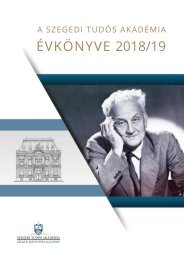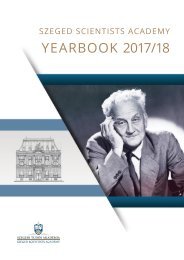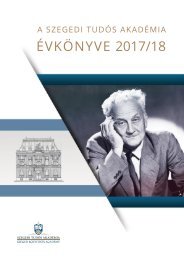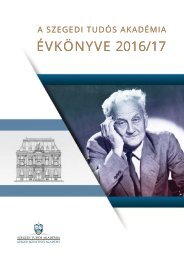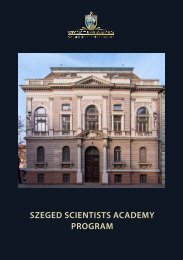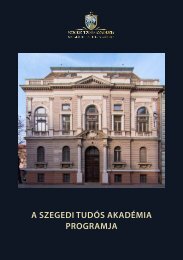SzSA YearBook 2016/17
Create successful ePaper yourself
Turn your PDF publications into a flip-book with our unique Google optimized e-Paper software.
SZENT-GYÖRGYI MENTORS<br />
GÁBOR JUHÁSZ<br />
Institute of Genetics,<br />
Biological Research Center of the<br />
Hungarian Academy of Sciences<br />
Address: Temesvári krt 62., H-6726 Szeged, Hungary<br />
E: juhasz.gabor@brc.mta.hu<br />
T: +36 62/599-793<br />
RESEARCH AREA<br />
Autophagy is one of the major degradative pathways in<br />
eukaryotic cells. During the main route, portions of cytosol<br />
and organelles are captured into double-membrane autophagosomes,<br />
which then fuse with lysosomes to deliver their<br />
cargo for degradation and reuse. Our group is studying the<br />
role and mechanisms of autophagy mainly using the popular<br />
animal model Drosophila. We are particularly interested<br />
in the mechanisms of autophagosome-lysosome fusion: we<br />
have identified several new fusion factors in recent years,<br />
and further ones are currently being characterized. The<br />
long-term aim of this project is to biochemically reconstitute<br />
autophagosome-lysosome fusion in vitro.<br />
TECHNIQUES AVAILABLE IN THE LAB<br />
Genetic manipulation of Drosophila: gene knockouts,<br />
transgenic reporter constructs, mosaic analysis. Confocal<br />
microscopy, autophagic degradation and endocytic uptake<br />
and degradation assays. Transmission electron microscopy.<br />
Western blots, immunoprecipitations, proteomic analysis<br />
(done by the core facility). Cell culture facilities, yeast<br />
two-hybrid, molecular cloning, RT-PCR and qPCR. Purification<br />
of recombinant proteins, biochemical assays, antibody<br />
production.<br />
SELECTED PUBLICATIONS<br />
Lorincz, P., Lakatos, Z., Varga, A., Maruzs, T., Simon-Vecsei,<br />
Z., Darula, Z., Benko, P., Csordas, G., Lippai, M., Ando, I.,<br />
Hegedus, K., Medzihradszky, K., Takats, S., Juhasz, G.<br />
(<strong>2016</strong>) MiniCORVET is a Vps8-containing hemocyte- and<br />
nephrocyte-specific early endosomal tether in Drosophila.<br />
Elife, 5. pii: e14226.<br />
Takáts, S., Pircs, K., Nagy, P., Varga, Á., Kárpáti, M., Hegedűs,<br />
K., Kramer, H., Kovács, A.L., Sass, M., Juhász, G. (2014) Interaction<br />
of the HOPS complex with Syntaxin <strong>17</strong> mediates<br />
autophagosome clearance in Drosophila. Mol Biol Cell 25:<br />
1338-54.<br />
Nagy, P., Varga, A., Pircs, K., Hegedus, K., Juhasz, G. (2013)<br />
Myc-Driven Overgrowth Requires Unfolded Protein<br />
Response- Mediated Induction of Autophagy and<br />
Antioxidant Responses in Drosophila melanogaster. Plos<br />
Genet 9: e1003664.<br />
Takats, S., Nagy, P., Varga, A., Pircs, K., Karpati, M., Varga, K.,<br />
Kovacs, A.L., Hegedus, K., Juhasz, G. (2013) Auto phagosomal<br />
Syntaxin<strong>17</strong>-dependent lysosomal degradation maintains<br />
neuronal function in Drosophila. J Cell Biol 201: 531-539.<br />
Juhász, G., Erdi, B., Sass, M., Neufeld, T.P. (2007) Atg7-<br />
dependent autophagy promotes neuronal health,<br />
stress tolerance, and longevity but is dispensable for<br />
metamorphosis in Drosophila. Genes Dev 21: 3061-6.<br />
54







